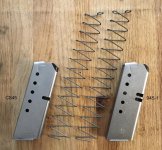I have a couple of 6906 magazines which could use new springs. I prefer OEM springs, which seem to have become extinct.
I had my Brownell's account set to alert me when they came in as they were listed as out of stock. I was surprised when I received an email this morning telling me they were in stock. I clicked on the link only to find that they were no listed as no longer available.
My only option appears to be Wolff 10% over power springs.
Is there any downside to using these? Conversely, is there any advantage to using these? Are there any other options?
I had my Brownell's account set to alert me when they came in as they were listed as out of stock. I was surprised when I received an email this morning telling me they were in stock. I clicked on the link only to find that they were no listed as no longer available.
My only option appears to be Wolff 10% over power springs.
Is there any downside to using these? Conversely, is there any advantage to using these? Are there any other options?

